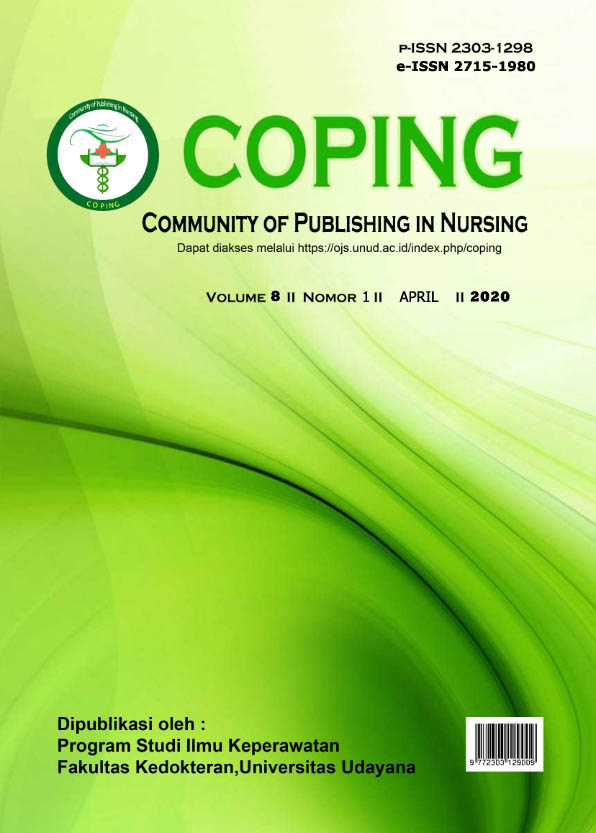Tingkat Ansietas Keluarga yang Merawat Lansia
Abstract
Jumlah lanjut usia atau lansia dari tahun ke tahun selalu mengalami peningkatan jumlahnya. Usia harapan hidup lansia saat ini mengalami peningkatan hingga usia 70-an tahun. Hal tersebut menunjukkan bahwa semakin panjangnya usia harapan hidup lansia, maka jumlah lansia akan mengalami peningkatan. Hal ini tentu akan berdampak pada peran sosial lansia, baik yang disebabkan karena kondisi fisik atau kesehatan, psikologis, sosial, maupun ekonomi lansia tersebut. Hal ini membuat lansia membutuhkan orang lain atau keluarga untuk memenuhi kebutuhan dasarnya. Beban keluarga dalam merawat lansia dapat menyebabkan perubahan psikologis salah satunya, yaitu ansietas. Penelitian ini bertujuan untuk mengetahui tingkat ansietas keluarga dalam merawat lansia di Bandengan Kota Kendal. Penelitian ini menggunakan metode deskriptif analitik dengan pendekatan kuantitatif. Sampel penelitian ini berjumlah 89 keluarga. Teknik sampling menggunkan purposive sampling. Alat pengumpul data menggunakan kuesioner. Data dianalisis secara distribusi frekuensi. Hasil penelitian menunjukkan bahwa rata-rata keluarga yang merawat lansia berusia 48 tahun, mayoritas berjenis kelamin perempuan, berpendidikan terakhir SLTP, dan berstatus tidak bekerja. Tingkat anseitas keluarga yang merawat lansia mayoritas berada dalam tingkat ansietas sedang.
Kata kunci: ansietas, keluarga, kesehatan fisik, lansia, merawat lansia
ABSTRACT
The number of elderly from year to year always increases in number. Life expectancy for the elderly is increasing until the 70s. This shows that the longer the life expectancy of the elderly, the number of elderly people will increase. This will certainly have an impact on the social role of the elderly, whether caused by physical or health, psychological, social, or economic conditions of the elderly. This makes the elderly need other people or families to meet their basic needs. Family burden in caring for the elderly can cause psychological changes, one of which is anxiety. This study aims to determine the level of family anxiety in caring for the elderly in Kendal City Bandengan. This research uses descriptive analytic method with quantitative approach. The sample of this research is 89 families. The sampling technique uses purposive sampling. Data collection tool using a questionnaire. Data analyzed by frequency distribution. The results showed that the average family caring for the elderly was 48 years old, the majority were female, had a high school education, and were unemployed. The level of anseitas family caring for the elderly majority is in the level of moderate anxiety.
Keywords: anxiety, caring for the elderly, family, elderly, physical health
Downloads
References
Friedman, M. (2010) Buku Ajar Keperawatan Keluarga : Riset, Teori dan Praktek, edisi 5, Jakarta : EGC.
Jütten, L. H., Mark, R. E., & Sitskoorn, M. M. (2019). Empathy in informal dementia caregivers and its relationship with depression, anxiety, and burden. International journal of clinical and health psychology, 19(1), 12-21.https://www.sciencedirect.com/science/article/pii/S1697260018301200
Leung, K. K., Chen, C. Y., Lue, B. H., & Hsu, S. T. (2007). Social support and family functioning on psychological symptoms in elderly Chinese. Archives of gerontology and geriatrics, 44(2), 203-213.https://doi.org/10.1016/j.archger.2006.05.001
Livana, P. H., & Wardani, I. Y. (2020). Karakteristik Keluarga Pasien Hemodialisis yang Mengalami Stres. Jurnal Ners Widya Husada Semarang, 6(3), 73-78.http://stikeswh.ac.id:8082/journal/index.php/jners/article/view/318
Livana, P. H., Keliat, B. A., & Putri, Y. S. E. (2016). Penurunan Respons Ansietas Klien Penyakit Fisik dengan Terapi Generalis Ansietas di Rumah Sakit Umum. Jurnal Keperawatan Jiwa, 4(1), 13-20. https://doi.org/10.26714/jkj.4.1.2016.13-20
Livana, P. H., Susanti, Y., Darwanti, L. E., & Anggraeni, R. (2019). Description Of Elderly Depression Levels. Nurscope: Jurnal Penelitian dan Pemikiran Ilmiah Keperawatan, 4(2), 80-93. http://dx.doi.org/10.30659/nurscope.4.2.80-93
Moss, K. O., Kurzawa, C., Daly, B., & Prince-Paul, M. (2019). Identifying and addressing family caregiver anxiety. Journal of Hospice & Palliative Nursing, 21(1), 14-20. doi: 10.1097/NJH.0000000000000489
Mubin, M. F., & Livana, P. H. (2020). Reduction of family stress level through therapy of psychoeducation of skizofrenia paranoid family. Enfermería Clínica, 30, 155-159. https://doi.org/10.1016/j.enfcli.2019.12.048
Mubin, M. F., Livana, P. H., & Mahmudah, A. R. (2019). Gambaran Tingkat Stres Keluarga Lansia. Jurnal Keperawatan Jiwa, 6(2), 128-133. https://doi.org/10.26714/jkj.6.2.2018.128-133
Notoatmodjo,S. (2010). Metodologi Penelitian Kesehatan. Jakarta : Rineka Cipta.
Posluszny, D. M., Bovbjerg, D. H., Syrjala, K. L., Agha, M., & Dew, M. A. (2019). Correlates of anxiety and depression symptoms among patients and their family caregivers prior to allogeneic hematopoietic cell transplant for hematological malignancies. Supportive Care in Cancer, 27(2), 591-600.https://link.springer.com/article/10.1007/s00520-018-4346-3
Sudawam, S., & Livana, P. H. (2017). Gambaran Tingkat Stres Lansia Dengan Hipertensi. Jurnal Ilmiah Permas: Jurnal Ilmiah STIKES Kendal, 7(1), 32-36. http://journal.stikeskendal.ac.id/index.php/PSKM/article/view/160
Sulistyowati, E., & Indria, D. M. (2020). Analisa Pengaruh Tingkat Kecemasan dan Depresi Pasien dengan Keluarga (Caregiver) terhadap Kualitas Hidup Pasien Kanker di Malang. Jurnal Bio Komplementer Medicine, 7(1).http://riset.unisma.ac.id/index.php/jbm/article/view/6642







